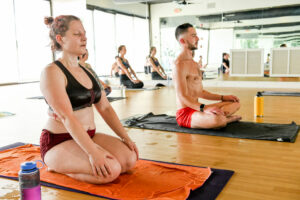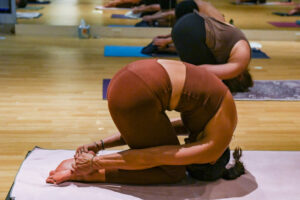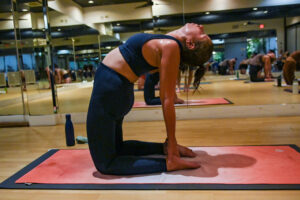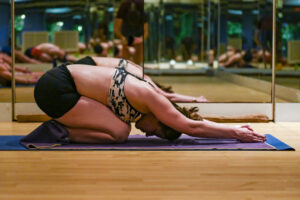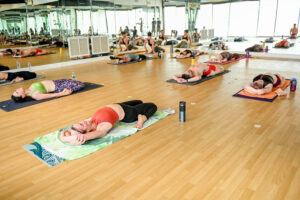Is the Standing Separate Leg Stretching Pose a cure for sitting?
Most of us sit for the majority of the day. That keeps our hamstrings contracted for hours on end. And you’ll know you have tight hammies the minute you try to bend down and touch your toes.
That’s why the best workouts focus on bringing balance to our bodies and our lives. The Standing Separate Leg Stretching Pose helps us balance our tendency to keep our legs bent for most of the day.
What is the Standing Separate Leg Stretching Pose?
In our OG Hot Yoga 26 & 2 classes, the standing separate leg stretching pose is the 8th pose in our 26 posture regimen. The sanskrit name is Dandayamana Bibhaktapada Paschimottanasana. We call it the standing separate leg stretching pose because you separate your legs before you stretch them. Of course, while you practice the pose in a standing position, you end up inverted while staying on your feet.
How to Perform the Standing Separate Leg Stretching Pose
You begin the pose with your feet together, standing straight. And just like you would greet the sunrise, you take both arms out to your sides and then straight over your head with your palms facing each other. Keep those shoulders down, and pulled away from your ears.
Our shoulders tend to get so tight as we crouch over our desks all day, typing away. And this is the perfect way to stretch the muscles in your sides that allow your rotator cuff to sit in the right place, so you can enjoy full shoulder movement. This is especially important as you age!
Once your arms are overhead, you’ll take a big step out with the right foot. Make sure your feet are more than shoulder width apart.
Immediately bring your arms out at your sides with your palms parallel to the floor. This is when you look a bit like a starfish all spread out.
Before you proceed, be sure your heels are in line with one another. And you’ll want your toes turned slightly toward each other. Lock those legs! (If I had a dollar for every time an instructor said this…)
Start your exhale, keep your legs locked and then you’ll bend over at the waist. You should be feeling that stretch in your hamstrings! Keeping your back straight and arched slightly and your arms out at your sides, move slowly toward the floor.
It’s okay if you can’t bend over that far when you first begin your practice! This position should not induce pain. If you’re feeling pain, you’re going too far too fast.
View our Tips for Beginners Here
Keep that chin up, away from your chest as you bring your chest toward your legs.
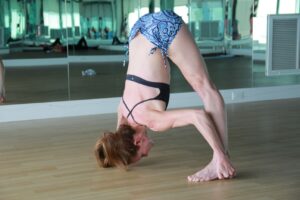
As an alternative, if you can’t touch your heels, you can grab the sides of your feet.
Give yourself an extra big stretch as you pull your heels upward with your hands to deepen the stretch.
Hold the position as instructed, then release.
The second round will allow you to go deeper into the stretch.
Biggest Benefits of the Standing Separate Leg Stretching Pose
Yogis throughout the years believe this position can help your circulation and adrenal gland function. They have also promoted decompression of the nerves as a benefit of this pose.
Sciatica Prevention and Relief
Inversions elongate your spine. Because the standing separate leg stretching pose includes an inverted position, you are automatically maximizing the space between the discs in your spine.
Sciatica – one of the leading causes of burning and pain in the back. And what leads to sciatica? Pinched nerves. One of the ways you relieve the symptoms of sciatica, is to give your discs room to take the pressure off of the nerve.
Enter inversions. Practicing an inverted position can give you extra space between your discs, so you can relieve the pain caused by a pinched nerve in the back.
Releasing the Hamstrings
We’ve already talked about the tension we create all day in our hamstrings from all the sitting we do. One way to bring balance to our hamstrings involves releasing that tension to give them a deep stretch.
Tight hamstrings can cause knee pain and back pain because they rotate the hips and pelvis backward. Tight hamstrings are also more prone to tears and strains. Leaving things tight can ultimately reduce your mobility, even simple walking can become more difficult.
If you suffer from tight hamstrings, it’s important to release your muscles slowly and progressively. That means take your time, work consistently, and go deeper with each practice.
Benefits of a consistent yoga practice.
Strengthening the Quadriceps
In order to correctly release the hamstrings, it’s important to tighten your quadricep or your thigh. Each muscle group has a corresponding muscle group. That means when you tighten one, you lengthen another. The hamstrings and quadriceps are corresponding muscle groups. If you’re having trouble fully bending forward, tightening your quads can help you get deeper into the stretch.
When your instructors says, “lock your knees,” one of the things they mean is tighten your quadricep. As you strengthen your quad, your hamstring will release further. And that’s why staying consistent with your practice will give you the best results.
Perfecting the Hinge
The hip hinge is one of the most important movements for you to master in order to protect your spine, strengthen your core, and prevent back and knee pain. As you age, this movement will also help you to continue to be able to lift items for yourself. And that’s a huge part of remaining autonomous for years to come.
Take a look at the hip hinge on a skeleton with our pal from Athelean X here.
Just think about lifting your grand babies out of a car or a stroller. Carrying your suitcase into a house as a visit. Or even unpacking your own groceries in your 70s and beyond. You need a stabilized back and a strong core to be able to complete these every day tasks. Perfecting your hip hinge helps you do that at any age.
Want to get more instruction on your standing separate leg stretching pose? Join Olivia Anselmo in our posture clinic for the triangle pose and the standing separate leg stretching pose.
 -ing our NEW! Community Classes!
-ing our NEW! Community Classes!
